Reserve Bank Bulletin – August 1999 The Economy and Financial Markets
Download the complete Statement 327KB
Prospects for the world economy have improved over recent months. The United States economy has continued its remarkable combination of strong growth and very subdued inflation. Economies in the euro area slowed late last year, affected by weakness in export markets, but are now seeing a solid expansion in domestic demand, which offers the prospect of stronger output growth before long. In Japan, the budgetary stimulus is acting to support economic activity, which appears to have reached a bottom during the second half of 1998. The fledgling recoveries in a number of Asian countries have continued, and in the case of Korea, the pick-up in activity over the past six to nine months has been unexpectedly strong. As a result of these developments, most forecasts of global growth are now being revised up, for the first time in two years.
These developments have been assisted by much more settled conditions in international financial markets. Last year, global markets were affected by a series of financial shocks, including the east Asian currency and banking crises, the Russian debt moratorium, and the problems of Long-Term Capital Management. The resulting stresses raised concerns about the functioning of financial markets and intermediaries even in the major countries, and prompted policy responses by the US Federal Reserve and other major central banks. During 1999, in contrast, financial markets have been much steadier. Capital flows have resumed to many of the countries at the centre of the Asian crisis, prompting a sharp pick-up in share prices, strengthening currencies and permitting falls in interest rates. Concerns about impairment of the credit process have receded, and share markets in developed countries have reached new highs, despite a slight tightening of US monetary policy. Australian financial markets have seen similar trends. There has been some rise in market interest rates on both short-term and long-term securities, as market participants, particularly those offshore, speculated that the Reserve Bank might follow its US counterpart in tightening monetary policy. There has also been continued strength in the share market, particularly in resource stocks, and some rise in the exchange rate of the Australian dollar.
The international trends offer the prospect that the external environment faced by Australian producers will gradually improve over the next couple of years. There is, nonetheless, some distance to go yet. While some commodity prices have risen in response to the expectation of stronger world growth, those most important for Australian exporters remain very weak. Moreover, while signs of better performance in Europe and Japan are welcome, it is likely that the world economy will need to cope with a slowdown in the United States at some stage in the next year. It is as yet uncertain whether private demand in Japan will gather enough strength to sustain growth in the economy. Nor should the progress in the east Asian economies obscure the fact that a long and arduous process of repairing and reforming financial and corporate structures remains to be completed. Hence the possibility of further setbacks cannot be entirely discounted.
Assuming the current gradual trend towards improved international conditions continues, benefits will in due course flow through for Australia. In the meantime, the effects of the decline in exports over the past year will be acting as a drag on Australian producers. The most visible current manifestation of this is in the current account deficit, but the apparent downward revisions to investment intentions are also partly attributable to the same forces. It still, therefore, seems likely that a period of slower economic growth in Australia will be observed in the period ahead, although it must be admitted that the weaker data for capital spending intentions are, at this point, the only clear evidence for this.
The risks of a larger or more protracted slowdown appear, however, to have lessened over the past six months. As of the March quarter, the economy was still recording growth in excess of 4 per cent, with strong domestic demand, particularly household consumption spending, making up for weakness in export performance. The current expansion, now entering its ninth year, is the longest since the 1960s. This has been associated with a decline in the rate of unemployment of about 4 percentage points since its peak – not quite as fast as in the 1980s upswing, but with much better prospects that it can be sustained.
Inflation remains quite low, in Australia as elsewhere. The CPI recorded an increase of 1.1 per cent over the most recent 12 months. This result was affected by the changes to health insurance arrangements; excluding this impact, the rise was about 1.5 per cent. A variety of ‘underlying’ measures of inflation put it between 1½ and 2 per cent, up a little from its low point in late 1997. The Bank's forecast is that inflation on a CPI basis will gradually increase, rising a little above 2 per cent during the first half of 2000. The recent rise in international oil prices, assumed in this forecast to persist, is one factor pushing inflation up. On an ‘underlying’ basis, inflation will likely remain at about 2 per cent through the first half of next year.
Barring further external shocks, the main economic event now on the horizon in Australia is the introduction of the tax reform package in July 2000. This will involve a one-time shift in the price level, accompanied by income tax cuts which, on average, more than offset any reduction in real income, such that there is a net fiscal expansion. The expected modest slowdown in the economy over the next few quarters should help to absorb this particular event. The fact that inflation is likely still to be quite low immediately before the GST's introduction will also assist.
The Bank will abstract from the one-time price level change associated with the GST, for the purposes of assessing the ongoing rate of inflation. It is, of course, important that those involved in wage and price decisions do the same. Prospects for that appear, at the present juncture at least, to be good, given the high degree of competitive pressure which characterises goods markets. The magnitude of the GST-induced price level change and the extent to which wage decisions are affected will need to be kept under close review over the coming 18 months.
The current trend in inflation, and its likely course over the next year to 18 months (abstracting from impact effects of the GST and assuming existing policy settings), appears, at present, to be consistent with achieving the inflation target on a medium-term basis. The Bank has, accordingly, seen no need to make any adjustments to interest rates since the change made last December.
International Economic Developments
The Americas
The United States economy has largely maintained its momentum over the first half of 1999 with little indication of more than a gradual slowdown. Despite growth faster than most estimates of potential for a sustained period and the continued tightness of the labour market, there are still few signs of inflationary pressure.
Real GDP expanded at an annual rate of 3.3 per cent in the first half of 1999 (Table 1). Growth in domestic final demand ran at 5½ per cent per annum over the same period. The main driving force continues to be consumption spending, which has been underpinned by solid employment growth, strong consumer confidence and rising household wealth. As has been the case for several years, growth in consumption has outpaced that in disposable income, leading, in recent quarters, to a negative household saving rate (as recorded by the national accounts). Consumers have, in part, financed their spending by realising some of the capital gains from their share holdings, or by borrowing against them.
| Mar qtr 1999 |
June qtr 1999 |
Year to June qtr |
|
|---|---|---|---|
| Private consumption | 1.6 | 1.0 | 5.0 |
| Dwelling investment | 3.6 | 1.3 | 10.0 |
| Business investment | 2.0 | 2.6 | 8.1 |
| Public expenditure | 1.0 | −0.3 | 1.9 |
| Change in inventories(a) | −0.1 | −0.2 | −0.3 |
| Exports | −1.3 | 1.1 | 3.7 |
| Imports | 3.2 | 2.3 | 9.3 |
| Net exports(a) | −0.6 | −0.2 | −1.0 |
| GDP | 1.1 | 0.6 | 4.1 |
| (a) Contribution to growth; percentage points. | |||
Reflecting strong growth in the US relative to most of the rest of the world, the US trade balance has declined over the past year and a half, leading to a current account deficit of just over 3 per cent of GDP in the March quarter. This is likely to have widened further in the June quarter, although the decline in net exports was less than in the March quarter, as export volumes rose. The latter has contributed to the mild recovery in the manufacturing sector over recent months.
Inflation remains subdued, despite a temporary spike in April resulting from higher world oil prices. The core inflation rate, at 2.1 per cent in the year to June, is close to the lowest so far this cycle. This outcome can largely be attributed to the slowdown in wages growth that occurred unexpectedly last year, combined with above average productivity growth. The continuation of such favourable outcomes cannot be counted on with the unemployment rate remaining at historic lows (Graph 1).
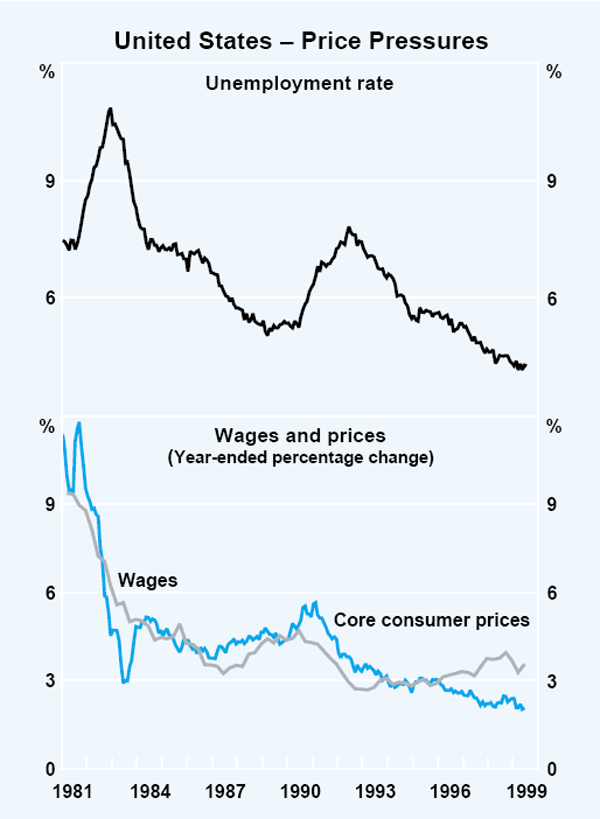
The Federal Reserve tightened monetary policy in June. As noted in the chapter on ‘Financial Markets’, this decision reflected an easing of concerns about the possible spillover of adverse developments in international markets to the US financial system. With the US economy continuing to grow strongly, the earlier lower level of interest rates was judged no longer to be necessary.
The continued strength of the US economy has benefited the Canadian economy, which grew at an annualised rate of 4½ per cent over the six months to March. Core measures of inflation, which averaged close to 1 per cent in 1998, have moved up by around half a percentage point over recent months.
In Latin America, although economic activity has generally been weak, surprisingly stable economic conditions have prevailed since Brazil's exchange rate devaluation in January. In Brazil, output has been stronger than most had expected and inflation lower. The government has announced the adoption of an inflation-targeting regime for the central bank, which aims for an inflation rate of 8 per cent this year, falling to 4 per cent by 2001. Output in Argentina has been weaker than in Brazil, as interest rates have remained reasonably high to maintain the exchange rate peg to the US dollar, and it has not had the expansionary effect of a lower exchange rate. With its economy more closely tied to that of the United States than either Argentina's or Brazil's, Mexico grew by almost 5 per cent last year, despite a slowing in the second half of the year as a result of high interest rates during the international financial crisis and also low oil prices. With these strains easing and continued strong growth in the United States, Mexico should experience reasonably robust growth this year.
Japan
The Japanese economy is showing some signs of recovery. Real GDP is estimated to have risen by 1.9 per cent in the March quarter, the first increase in a year and a half, and well above what had been expected (Table 2). Final spending by the government, as part of the fiscal package announced last year, directly accounted for half of the increase, but there was also an increase in private spending.
| Dec qtr 1998 |
Mar qtr 1999 |
Year to Mar qtr |
|
|---|---|---|---|
| Private consumption | −0.2 | 1.2 | 0.8 |
| Dwelling investment | −7.0 | 1.2 | −9.8 |
| Business investment | −5.5 | 2.5 | −10.2 |
| Public expenditure | 4.6 | 5.4 | 11.1 |
| Change in inventories(a) | 0.0 | 0.0 | −0.2 |
| Exports | −3.2 | −0.3 | −3.7 |
| Imports | −0.8 | 1.8 | −5.0 |
| Net exports(a) | −0.4 | −0.2 | 0.1 |
| GDP | −0.8 | 1.9 | 0.1 |
| (a) Contribution to growth; percentage points. | |||
At this stage, it remains unclear whether private-sector demand will achieve enough momentum to keep the recovery going once the fiscal stimulus comes to an end. There are, however, some encouraging signs. Data on household expenditure suggest further increases during the June quarter. It is possible that consumption will be constrained by weakness in household income growth, as a result of higher unemployment and subdued real wage growth. On the other hand, there is ample scope for Japanese households to reduce saving, provided they are confident enough to spend. On this front, consumer sentiment has been recovering from the lows recorded last year, although it remains weak.
Business optimism about the state of the economy has improved, according to the Tankan Survey, and firms currently expect this trend to continue. They also perceive that the availability of credit from banks has improved, suggesting that some progress has been made in relieving problems in the banking sector. To date, manufacturers have been meeting demand by running down excess stocks rather than increasing production, but the run-down in inventories suggests that production will begin to grow if the demand expansion continues. Reflecting substantial and persistent excess industrial capacity, firms expect to curtail investment spending over the course of this year.
Non-Japan Asia
The Asian economies initially affected by the crisis in 1997 appear to be on the path to recovery, although there are differences in the strength and composition of the upswing (Graph 2). Korea, which was the first of these countries to emerge from recession, has experienced the strongest recovery in activity with output nearing pre-crisis peaks: GDP has risen at an annual rate of 4½ per cent since the trough in the June quarter last year. In Thailand and Indonesia, where the contractions in activity were sharper, output has been rising since the end of last year but still remains well below pre-crisis levels.
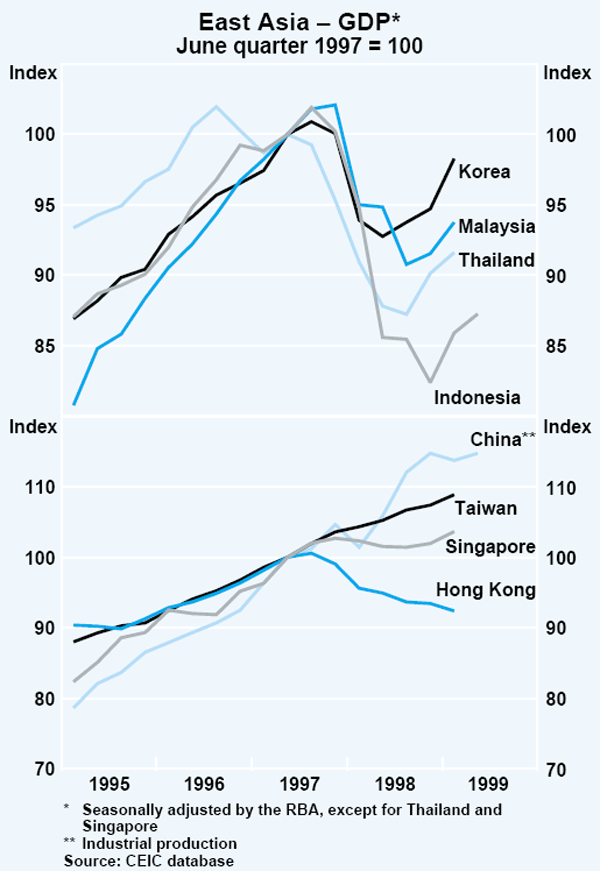
In each of the countries, the initial impetus to activity has come primarily from spending by consumers and the public sector, supported by expansionary macroeconomic policies. Imports have also picked up over the past six months – particularly in Korea – which has capped the rise in the current account surpluses. Private investment remains weak, however, reflecting the presence of significant excess industrial capacity. External demand is now also beginning to be more supportive of activity following rather lacklustre export growth over the course of last year. To date, Korea has posted the most impressive export performance, with volumes up by 11½ per cent in the March quarter, compared with an average growth rate of 2 per cent per quarter over the course of 1998. Much of the acceleration in exports reflects stronger world demand for electronics, which has also benefited other countries with large electronics sectors (notably Malaysia and Taiwan). Thailand and Indonesia are yet to experience a substantial turnaround in export growth.
Gradual progress continues to be made in the long process of restructuring the financial sectors within the initial crisis economies. Financial sector reform is well advanced in Korea, with developments over recent months largely centred on the disposal of non-performing loans held by Korea's asset management company. In Malaysia, the government's asset purchasing vehicle has purchased around one-third of non-performing loans from banks and the recapitalisation of the banking sector is well under way. In Thailand and Indonesia, some progress has been made in the recapitalisation of banks in recent months. This has largely come from private sources in Thailand, while public funds have predominantly been used in Indonesia.
Recent trends in activity across the rest of east Asia have been more disparate. Activity in Taiwan and Singapore is picking up, with exports having strengthened over recent months, although, while domestic demand in Singapore is also increasing, in Taiwan it looks to have weakened. By contrast, output in Hong Kong has now declined for six successive quarters, to be 8 per cent lower in the March quarter than its peak in the September quarter 1997. This is primarily due to a sharp fall in private investment and continued weakness in consumption, although more recent retail sales data suggest that consumption may have started to pick up in the June quarter. In China, it appears that the fiscal stimulus, which has driven growth since the second half of 1998, has lessened. This is evident in industrial production, which has remained basically flat over the first half of this year. More positively, exports have strengthened since the beginning of the year, after having fallen significantly through 1998.
Following the mild recession in the first half of 1998, the New Zealand economy continues to recover. The production measure of output grew by 0.7 per cent in the March quarter to be 1½ per cent higher than a year ago. As was the case in the December quarter, growth was broadly based, with both investment and private consumption continuing to grow steadily. The pick-up in activity has been reflected in an improving labour market, with the unemployment rate falling three-quarters of a percentage point in the first half of the year to 7.0 per cent. Underlying inflation picked up a little in the June quarter, with prices increasing by 0.5 per cent to be 1.2 per cent higher over the year.
Europe
In the core European economies, there are signs of stronger domestic spending, especially in Germany and Italy. Growth in household expenditure across the region has been supported by a high level of consumer confidence and a modest reduction in the unemployment rate. To date, much of the increase in demand has been absorbed by a slowing in the rate of stock accumulation which, in tandem with further declines in export volumes, has limited the pick-up in manufacturing output (Graph 3). Nonetheless, business sentiment regarding future production has improved, due partly to a rise in foreign orders, the decline in the value of the euro and the April easing in monetary policy. Price pressures across the euro area remain subdued, with the year-ended rate of inflation remaining close to 1 per cent over recent months, despite the effect of the rise in oil prices.
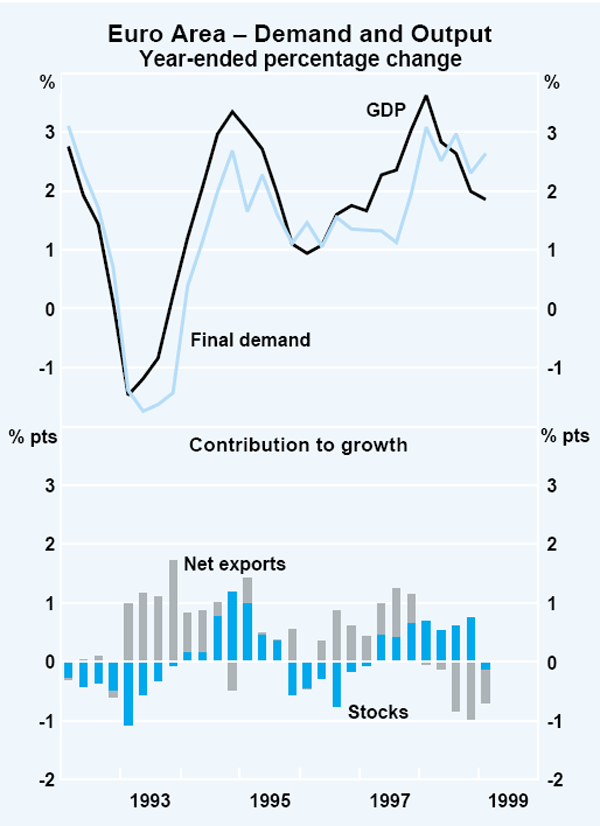
In the United Kingdom, manufacturing activity has been weak over the past year as a result of the slowing in global growth as well as the strength in the pound, although GDP has begun to recover, increasing by 0.5 per cent in the June quarter. Domestic demand, particularly consumption, remains strong, boosted by a reduction in interest rates by the Bank of England of 2½ percentage points since October last year. Inflation has remained close to the target rate of 2½ per cent.
Oil price developments
Since the announcement of OPEC production cuts in early March, the price of oil has increased by over 45 per cent to around US$21 a barrel, and is almost double the price at the trough in December 1998. The increase brings the price back to the level in late 1997. The price has been supported by the adherence of the OPEC producers to their agreed production levels, and also by declining petroleum inventories in most major industrial countries. Improved prospects for the global economy should help underpin the higher price going forward. To date, the rise in oil prices has added between one-quarter and one-half of a percentage point to headline inflation rates in the major industrial countries.
Domestic Economic Activity
The Australian economy has continued to grow strongly, maintaining an annual growth rate in excess of 4 per cent since mid 1997 (Graph 4). Over the year to the March quarter, GDP increased by 4.8 per cent, and the most recent indicators point to further growth in the June quarter, although probably at a reduced pace. Recent growth has been driven by a continued expansion of domestic demand, while exports have weakened, reflecting a still difficult external trading environment (Table 3). The net effect has been a further widening of Australia's current account deficit (see the chapter on ‘Balance of Payments’).
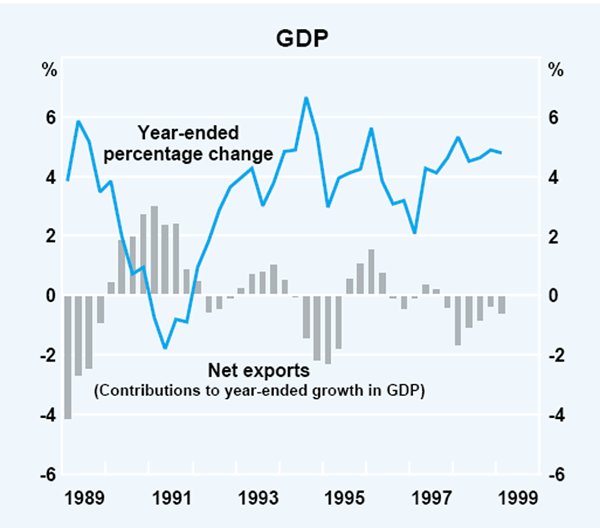
| Six months to: | Year to Mar 1999 |
||
|---|---|---|---|
| Sep 1998 | Mar 1999 | ||
| Private final demand(a) | 4.2 | 5.6 | 4.9 |
| Consumption | 4.2 | 6.4 | 5.3 |
| – Goods | 6.3 | 4.2 | 5.2 |
| – Other(b) | 3.7 | 9.2 | 6.4 |
| Dwelling investment | 6.8 | −1.6 | 2.6 |
| Business investment(a) | 4.9 | 4.4 | 4.6 |
| – Machinery and equipment(a) | 4.5 | 12.4 | 8.3 |
| – Other buildings and structures(a) | 11.9 | −14.4 | −2.2 |
| Public final demand(a) | 5.5 | 3.5 | 4.5 |
| Change in inventories(c) | −2.3 | 1.5 | −0.4 |
| Net exports(c) | 1.4 | −2.6 | −0.6 |
| GDP | 4.2 | 5.3 | 4.8 |
|
(a) Excluding transfers between the public and private sectors. (b) Excluding dwelling rent. (c) Contributions to growth in GDP. |
|||
The most important contributor to the growth of domestic demand over the past year has been consumer spending. This has been supported by several factors including strong growth in personal credit, rising household wealth and high levels of consumer confidence. Business confidence is also at a high level in most industries, with mining the most notable exception. Despite the high level of confidence, business survey results have pointed to a weaker investment outlook over the year ahead, which could imply some easing in the overall rate of growth of domestic demand. A significant decline in export earnings has contributed to the downward revisions to business investment plans, and may dampen domestic incomes and spending more generally in the period ahead. However, other aspects of the business environment, including a high level of profits, low interest rates and readily available finance, remain supportive of growth.
Household expenditure, income and wealth
Following rapid growth throughout much of 1998, consumption recorded an even stronger rate of increase in the early part of 1999. Most of the recent strength of consumption has been in components of a largely discretionary nature. Spending on staple items, such as food, utilities and health, continues to expand at a solid rate, but spending on items of a more discretionary nature – such as recreation & culture and hotels & cafes which together now account for more than one-fifth of consumption – has picked up noticeably.
Retail sales have shown a somewhat uneven pattern of growth during the first half of 1999, with an exceptionally strong increase in the March quarter followed by a small decline in the June quarter (Graph 5). This pattern appears to have been affected to some extent by the timing of Easter, which has meant that Easter spending this year was concentrated in March rather than April, as is more usual. Nonetheless, the two quarters together indicate strong growth, with nominal sales increasing at an annual rate of 9 per cent over the six-month period. The June quarter national accounts will incorporate some adjustment to reflect the early Easter, which should result in recorded consumption being spread more evenly between the two quarters. Motor vehicle purchases have been relatively steady since the middle of 1998, but nevertheless remain at a high level, following rapid growth over the previous year.
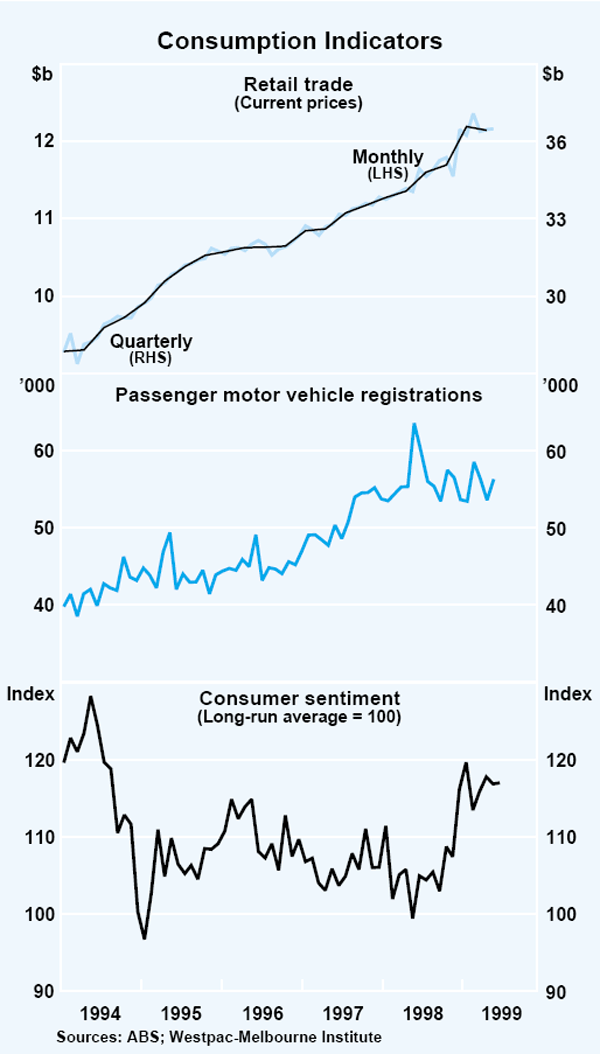
Since late last year the strength in consumption has coincided with a rebound in consumer sentiment. According to the Westpac-Melbourne Institute survey, consumers have been reporting greater optimism concerning employment prospects, their personal financial situations, and the economy more generally. Consumers also reported being very positive about buying major household items in the first half of the year. However, this aspect of consumer sentiment turned down in July, a result which may reflect anticipated declines in wholesale taxes on many household items. In particular, the wholesale tax rate applying to ‘black goods’ such as televisions, videos and disc players was reduced from 32 per cent to 22 per cent in July, and will be replaced by the 10 per cent goods and services tax in the middle of next year. Taxes on motor vehicles will also be significantly reduced. The forthcoming price reductions might induce some deferment of consumer spending on the items affected, although the extent of such behaviour could be moderated by some bringing forward of price reductions by producers.
Consumption growth over the past year has generally run ahead of growth in household disposable incomes. Over the year to the March quarter, consumption increased in real terms by 5.3 per cent, compared with growth of 3.3 per cent in real household disposable income. This brought the household saving rate down to 0.6 per cent in the March quarter, which is close to its lowest recorded level. A broader measure of saving, the total gross saving of households and enterprises, has shown a more moderate decline, from around 17 per cent to 15½ per cent of GDP over the past year (see the May 1999 Semi-Annual Statement on Monetary Policy, Box B).
The strong growth of consumption, and the associated decline in saving rates, has been encouraged by increases in asset values which have contributed to solid growth in household wealth (Table 4). This in turn is likely to have boosted consumer confidence and may also have supported growth of household borrowing. Household wealth increased by 2½ per cent in the March quarter and by 11 per cent over the year, due mainly to continued increases in house prices and, to a lesser extent, equity prices. The value of households' direct share holdings rose by 4 per cent in the March quarter and by 35 per cent over the year, more than half of which reflected valuation effects. Aggregate household wealth has risen by a total of about 35 per cent over the past three years. Part of the strength of consumption is also attributable to the increase in wealth available to households from the AMP demutualisation and the capital gain from the first stage of the Telstra float last year; these probably had their main impact on consumer spending around the end of 1998 and early 1999.
| Level $b | Share of total wealth per cent |
Year-ended growth per cent |
Average annual growth since March 1996 per cent |
|
|---|---|---|---|---|
| Dwellings | 1,410 | 55.0 | 11.0 | 11.7 |
| Consumer durables | 116 | 4.5 | 2.9 | 2.7 |
| Financial assets | 1,039 | 40.5 | 11.2 | 11.3 |
| of which: | ||||
| – Currency & deposits | 244 | 9.5 | 5.8 | 6.8 |
| – Equities | 181 | 7.1 | 34.5 | 22.3 |
| – Superannuation and life offices | 536 | 20.9 | 7.1 | 11.0 |
| – Other | 78 | 3.0 | 13.1 | 8.2 |
| Total wealth | 2,566 | 100.0 | 10.7 | 11.1 |
|
Sources: ABS; CBA/HIA Housing Report. |
||||
Strong consumption has also been underpinned by the low interest rate environment. Personal credit slowed a little in the past few months but nonetheless grew at an annual rate of around 16 per cent over the first half of the year, driven by increased use of revolving credit products such as overdrafts and credit cards, as well as home equity loans for non-housing purposes. Credit for housing increased at an annual rate of 14½ per cent over the same period.
With total credit to households growing at an annual rate of 14–15 per cent over the first half of 1999, households' aggregate debt/disposable income ratio has continued to rise (Graph 6). Even so, the household debt-servicing burden – the ratio of aggregate interest payments to income – fell slightly in the March quarter. This mainly reflects the fall in mortgage lending rates following the 25 basis-point reduction in the cash rate in December. On average, the servicing burden remains at comfortable levels, despite a doubling in the debt-income ratio in the past 20 years. However, it is likely that this average masks considerable variation across households, and debt-servicing burdens must be considerably higher for some borrowers.

The housing market
After a lull around the September quarter of last year, housing activity picked up in late 1998. Subsequently this momentum has been maintained, although the various indicators are providing contrasting signals about the ongoing strength of the recovery (Graph 7). Measures of financing have grown strongly but indicators of building approvals or work done have been fairly flat, albeit at high levels. Housing credit is growing at an annual rate of around 14½ per cent, compared with rates of around 11 per cent towards the end of 1998. The stronger growth in loan approvals, particularly for existing housing, is indicative of increased turnover of the housing stock, which in the past has tended to spill over into demand for new houses with a lag. On balance, this suggests some likelihood of a pick-up in housing activity later in the year.

The increase in demand for housing suggested by the growth of loan approvals may be contributing to upward pressure on house prices, particularly if the loans fund the purchase of existing dwellings. Median house prices in Melbourne and Sydney are more than 10 per cent higher than a year ago (Graph 8), while house prices in the other capital cities have generally been more subdued. Median rents have been growing at around 4 per cent per annum, although this masks strength in Melbourne and Perth and relative weakness in Brisbane and Sydney.

The business sector
The overall business climate remains favourable, with businesses experiencing strong growth in production and profits over the past year. However, there are some significant differences in conditions across industries. The mining sector in particular has experienced difficult conditions resulting from low commodity prices, which have contributed to reduced profits and cutbacks in production. Mining output declined by 3 per cent over the year to the March quarter, although there appears to have been some rebound at the end of that period. The manufacturing sector, which is also relatively exposed to external trade, has performed better over the past year. Production increased by 5 per cent, although to some extent this was absorbed by growth in inventories rather than in sales. Growth in the services industries remains robust, with particularly strong growth in property and business services, communications, and accommodation, cafes and restaurants.
Reflecting the overall strength of demand and output, profits have grown rapidly, with the gross operating surplus of corporate enterprises increasing by 13 per cent over the year to the March quarter. This measure of profitability now stands at 16 per cent of GDP, a record level, although it has to some extent been boosted by privatisations and the longer-term trend towards incorporation of businesses. As noted above, however, conditions have been quite disparate across industries. In the mining sector, profits declined by 8 per cent over the year, while there was strong profit growth in the service industries and moderate growth in manufacturing profits (Graph 9).
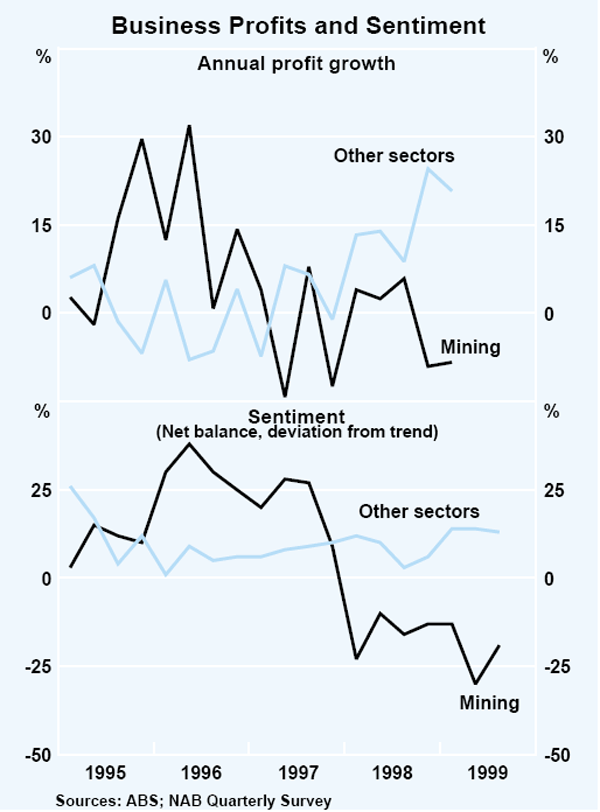
Recent business surveys have been consistent with these developments. The June quarter NAB Survey showed that business sentiment has remained fairly strong over the first half of 1999, after improving significantly towards the end of last year, and also revealed that most firms expect these healthy conditions to continue over the year ahead. It pointed to some improvement in conditions expected by mining companies, albeit from a very low level, perhaps reflecting improved sentiment regarding the Asian economies and recent increases in some commodity prices. Business conditions for manufacturing and wholesaling firms deteriorated slightly in the June quarter but remain close to longer-run average levels, while conditions improved further in several other industries including retailing, transport, storage and communications, financial services, and construction.
Despite the favourable conditions in most industries, there has been a slowing in the rate of growth of business investment recently. After a long upswing during which growth in investment spending had averaged over 10 per cent per annum, the level of business investment has followed a saw-tooth pattern since mid 1998 with little further net growth – there was a sharp increase in the March quarter itself, reversing a decline in the December quarter, but indications from the ABS Capital Expenditure Survey are that there will be a sharp decline in the June quarter. The overall easing of growth in business investment over the past year is partly accounted for by a large decline in mining investment from the high level reached in mid 1998. Over the three quarters to March 1999, mining investment declined by almost 30 per cent. Investment in manufacturing also declined over that period, but there was continued growth in investment in the service and construction industries.
The Capital Expenditure Survey also suggests weak investment intentions for the year ahead, although the preliminary nature of this estimate means it should be treated with some caution. According to the survey, firms in the mining, construction and accommodation industries expect a substantial reduction in investment in 1999/2000, while sizeable increases are planned in a few industries, such as retailing and the electricity, gas and water industry. In aggregate, and assuming average realisation ratios, the survey would imply a decline in the level of business investment in the year ahead.
The expected weakness in investment in buildings and structures implied by the ABS survey appears consistent with other forward indicators for that component of investment spending. Private non-residential building approvals are not at a level which is sufficient to support the present high rate of non-residential construction. There has also been a decline in the stock of work yet to be done on engineering construction projects. Looking further ahead, the Access Economics Property Monitor reports a decline in the value of major new construction projects currently under consideration.
Other business surveys suggest a less pessimistic reading of the overall investment outlook. Since the start of the year, the NAB survey has recorded an above-average net balance of firms expecting to increase their investment over the year ahead, after a period of weaker investment intentions during the latter part of 1998. The ACCI-Westpac survey of the manufacturing sector points to a somewhat stronger pick-up in investment plans recently. This appears consistent with other results pointing to a relatively high level of capacity utilisation at present.
Also at odds with the weaker investment outlook depicted in the Capital Expenditure Survey results is the current highly supportive financial environment for businesses. The level of interest rates on business loans is at historically low levels, and businesses report finding it easier to obtain finance than they did last year.
This is borne out by the growth of business funding (Graph 10). Borrowing by businesses from financial intermediaries, as well as direct debt and equity raisings, has shown solid growth of late. Although not as strong as earlier in the year, business credit increased at an annual rate of 8 per cent over the first half of the year. Non-intermediated debt raisings (excluding asset-backed issues, which do not generally fund non-financial businesses' investment activity) have been strong in 1999 to date, after a weaker period in the second half of last year. Similarly, new equity issues are estimated to have remained at a high level in the June quarter, following strong March and December quarters. Given the availability and low cost of funding, businesses would appear to have considerable scope to finance investment in the period ahead. The strength of business profits and the low level of interest rates also means that, despite a solid build-up in debt, and a gradually rising debt-to-equity ratio, interest burdens remain well below recent peaks.
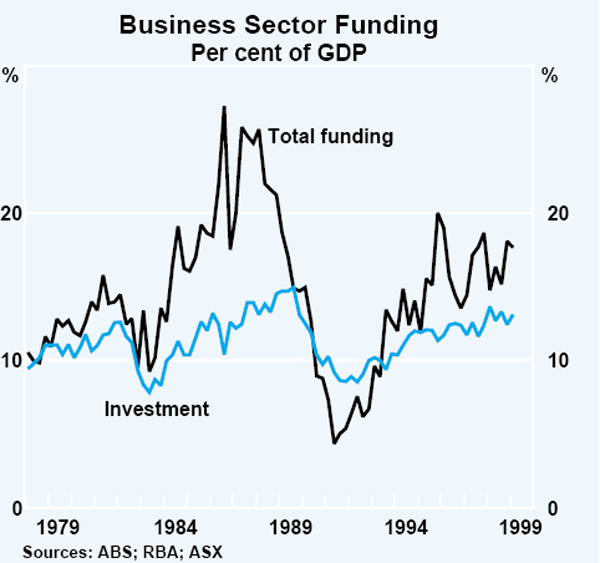
There are several ways in which the contrast between the weaker investment intentions recorded in the Capital Expenditure Survey, and the strong growth of business funding, might be resolved. One is that corporate funding growth may decline in the period ahead to be more consistent with a weaker investment outlook. Another possibility is that some of the growth in business funding is related to corporate takeover activity rather than to new investment. There is some evidence that this has been occurring, although its extent does not seem to be large enough to provide the main explanation for the recent strength of corporate funding. Finally, investment may turn out to be stronger than is currently suggested by the ABS survey.
The labour market
For much of the first half of this year, recorded employment growth, particularly full-time employment, had appeared to be at odds with the continued strength in output growth. While the monthly employment data are volatile, the large rise in employment recorded in June has gone some way to restoring the historical relationship between output and employment. Employment growth of 2.1 per cent over the past year has contributed to a reduction in the unemployment rate to 7.2 per cent in June, a full percentage point lower than the rate a year earlier (Graph 11). The participation rate has also fallen slightly over the past year.
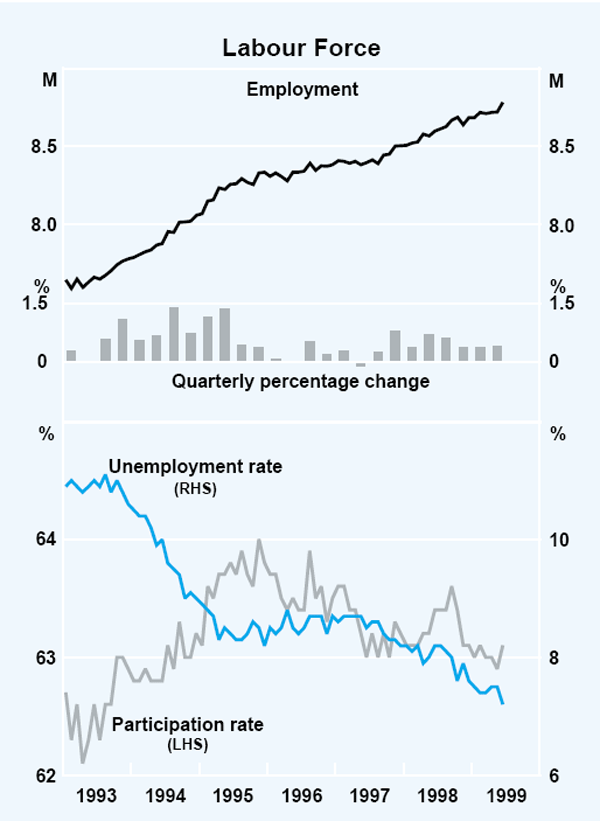
The participation rate has moved somewhat differently compared with the trends observed in recent periods of similar strength in the economy in 1989 and 1995. It appears that this reflects a slowdown in the long-term trend increase in female participation in the labour force. The female participation rate is now broadly comparable to that in the major industrial countries.
The relatively weak employment data up to May, the latest month for which industry employment data are available, conceal the robust employment growth recorded for a number of industries, including retail trade and public administration, which together accounted for more than three-quarters of the 1 per cent growth in employment over the six months to May. However, employment declines in mining, personal and other services, and finance and insurance over the same period reduced total employment growth by two-thirds of a percentage point. The decline in the manufacturing industry workforce over the past 18 months appears now to have halted.
Forward-looking indicators of labour demand remain firm (Graph 12). The newspaper-based measure of job vacancies reported by the ANZ Bank has increased by more than 6 per cent over the three months to July, to be around 20 per cent higher than a year earlier. While the broader ABS survey of job vacancies reported by employers has been unusually volatile over the past year, it rose strongly in the three months to May, and is at historically high levels for both the private and public sectors. The hiring intentions recorded in the major business surveys are also suggestive of ongoing demand for new labour.
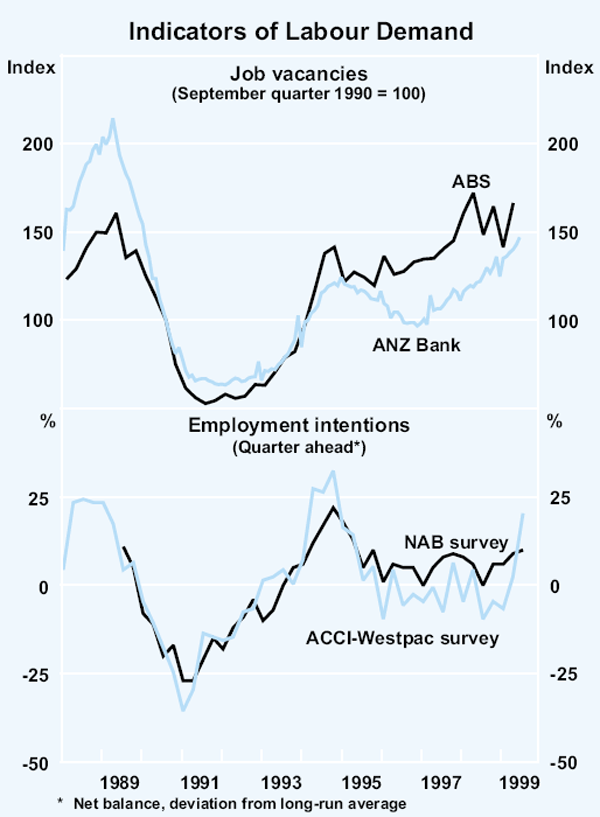
The combination of strong growth in output and weak recorded employment growth in the early months of the year saw a continuation of the good productivity performance of the previous seven quarters. Measured aggregate productivity in the economy, based on output per hour worked, rose by a little over 1 per cent in the March quarter, with year-ended productivity growth around 2¾ per cent. With the likelihood of some further catch-up in employment growth and a decline in output growth in the months ahead, there may be some slowing in productivity growth from its recent high rate.
Balance of Payments
The subdued state of the world economy continues to have an adverse impact on Australia's exports. In the June quarter, export earnings declined by around 3 per cent, with the total fall over the past year around 8½ per cent. While price reductions continue to be the dominant factor underlying the loss in export revenues, export volumes also declined over the six months to March and are likely to have eased further in the June quarter.
Much of the weakness in exports over the past year has been in resource exports, again reflecting both price and volume declines (Graph 13). There were further sharp price reductions in the June quarter as previously negotiated cuts to coal and iron ore prices took effect, combined with the effects of a further fall in the price of gold and the appreciation of the Australian dollar. Revenues from rural exports have also weakened, declining by around 4½ per cent over the past year because of continued price falls, despite strong growth in production and some recovery in demand from Asia. Manufactured export revenues have declined by around 4½ per cent over the past year, compared with average growth of about 14 per cent in the period 1990–1997. In contrast, service export revenues increased slightly in the June quarter, with some recovery in tourism from the east Asian region.
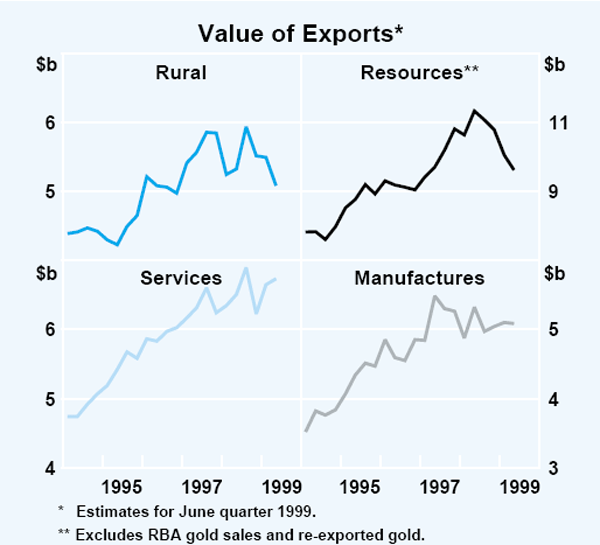
Since the onset of the Asian crisis, the decline in exports to the crisis-affected countries has been offset by stronger sales to other markets such as the US and Europe, particularly for resource exports. More recently, the aggregate data suggest that this export diversion may be slowing. However, the changing pattern of gold exports over the past three years has significantly complicated the picture.
There were two important developments in this regard. The first was a sharp swing in gold exports to Korea. From 1994 to 1996, the value of gold exports to Korea increased fourfold. Then, from early 1997 (some months before Korea felt the impact of the Asian crisis), the value of gold exports to Korea began to drop away sharply until, by early 1998, it had returned to 1994 levels. The impact of this was offset by the diversion of these gold sales to other markets, including Hong Kong, Singapore and Switzerland in 1997, and then to the US and UK in 1998 (Graph 14). A second factor, which began to affect Australia's gold exports after the onset of the Asian crisis, was the rapid growth in imports of gold from the crisis-affected Asian economies, for subsequent re-export. This peaked in the June quarter 1998, when re-exported gold accounted for around 40 per cent of Australia's total gold exports. Excluding re-exported gold, the value of Australia's gold exports increased more moderately over the year to June 1998 and has since declined sharply, reflecting both price reductions and some decline in volumes.
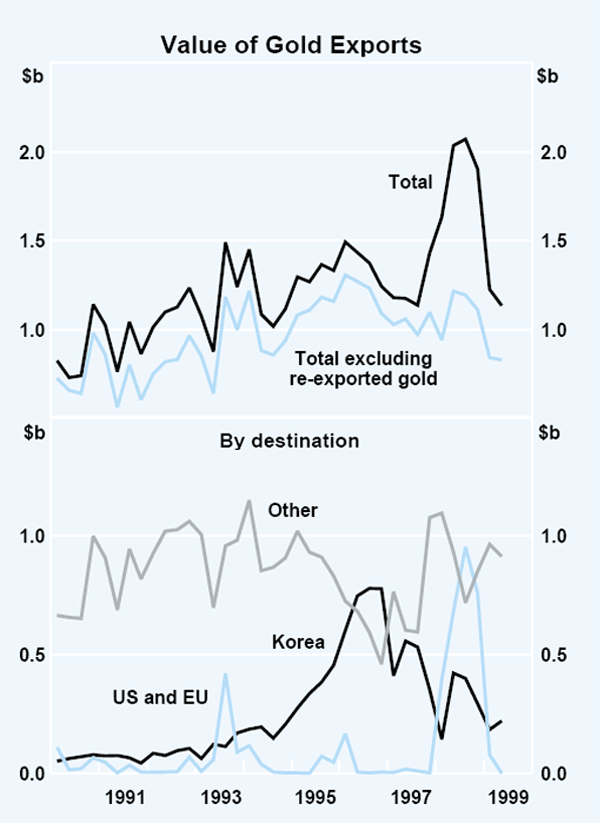
Abstracting from gold exports, growth in the value of resource exports to Korea declined only modestly in the post-crisis period, while there was a more pronounced slowing in resource export growth to the other crisis-affected economies. This was initially offset by a strong pick-up in resource exports to the US and Europe, which increased by 38 per cent over the year to June 1998 (Table 5). More recently, despite continued growth in volumes, the value of exports to those destinations has fallen, reflecting further declines in commodity prices in foreign currency terms and the appreciation of the Australian dollar. While the value of non-gold resource exports to the crisis-affected economies is no longer falling, this has been more than offset by falls in the value of exports to other destinations, contributing to an overall decline in the value of Australia's resource exports excluding gold of 12 per cent over the past year.
| June qtr 1997 |
June qtr 1998 |
June qtr 1999 |
|
|---|---|---|---|
| US and EU | 6.3 | 38.0 | −9.2 |
| Japan | 3.8 | 10.5 | −15.3 |
| Initial crisis Asia | 4.6 | −0.4 | 0.0 |
| Other east Asia | −1.6 | 6.6 | −18.0 |
| Rest of world | 37.1 | 32.6 | −16.6 |
| Total | 6.4 | 15.3 | −12.0 |
Expenditure on imports fell by 0.7 per cent in the June quarter to be only 2 per cent higher than a year ago. The declines in consumption and capital goods imports in the quarter more than offset a rise in intermediate imports. The decline in capital imports, however, was considerably less than the overall reduction in capital expenditure indicated by the Capital Expenditure Survey for the June quarter.
Preliminary indications are that import volumes continued to grow strongly in the June quarter to be around 9 per cent higher over the past year. Import prices are likely to have declined further in the quarter following six months of large price reductions. In part, the weakness in the overall measure of import prices reflects the significant appreciation of the Australian dollar since the start of the year. However, it also reflects the effect of compositional change driven by the growing importance of computer imports. These effects may be partially revised away when the ABS updates the reference year to 1997/98, resulting in smaller import price declines and consequently weaker estimates of volume growth over the past year or so.
Since the onset of the Asian crisis, the current account deficit (excluding RBA gold) has widened from around 3 per cent of GDP to just under 6 per cent as at the March quarter 1999 (Graph 15). In the June quarter, a significant decrease in the value of exports, only partially offset by a modest decline in the value of imports, suggests that the trade component of the deficit widened further by around ½ per cent of GDP. Assuming the net income deficit remains roughly unchanged as a proportion of GDP, this would imply a current account deficit of around 6¼–6½ per cent of GDP in the quarter.
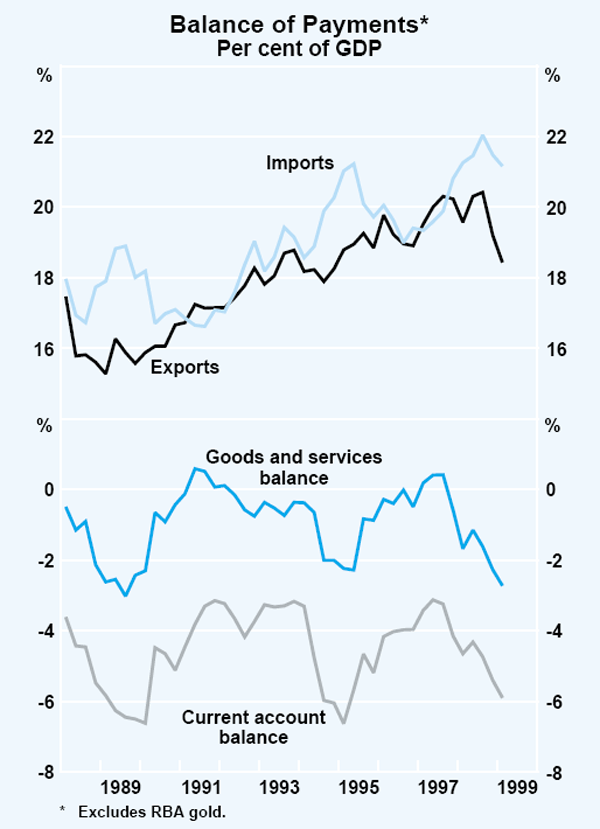
Net foreign debt rose by $2.6 billion in the March quarter to $241.6 billion, equivalent to 41.1 per cent of GDP. Total net foreign liabilities of Australians (including equity liabilities) increased by $10.5 billion in the March quarter to $354.2 billion or just over 60 per cent of GDP. The net income deficit was $4.9 billion in the March quarter, a little higher than in the December quarter, mainly reflecting increases in foreigners' income from direct ownership of Australian businesses. The ratio of net income payments to exports increased to 16.2 per cent in the March quarter, from 15.6 per cent in the December quarter, but remains near its historical average.
Commodity prices
In aggregate, commodity prices in SDR terms fell again in the June quarter to be down by over 11 per cent from the levels of a year ago (Graph 16). The fall in the quarter was due to declines in non-rural commodity prices (excluding base metals) of over 5½ per cent, reflecting the recently negotiated cuts to bulk commodity prices (iron ore and coal) and the fall in the price of gold. The sale of 25 tonnes of gold by the Bank of England (with planned sales of 415 tonnes over 5 years) and the prospect of gold sales by the IMF to finance debt relief for developing countries have contributed to the continued weakness in gold prices. In contrast, rural and base metals prices increased strongly in the quarter in SDR terms to be around 7 and 10 per cent higher, respectively, than their levels at the beginning of the year. These price rises reflect, in part, some improvement in market sentiment about the outlook for the world economy, but also tighter supply of a number of rural commodities, including beef and high-quality wool, and announced production cutbacks for a number of the base metals.
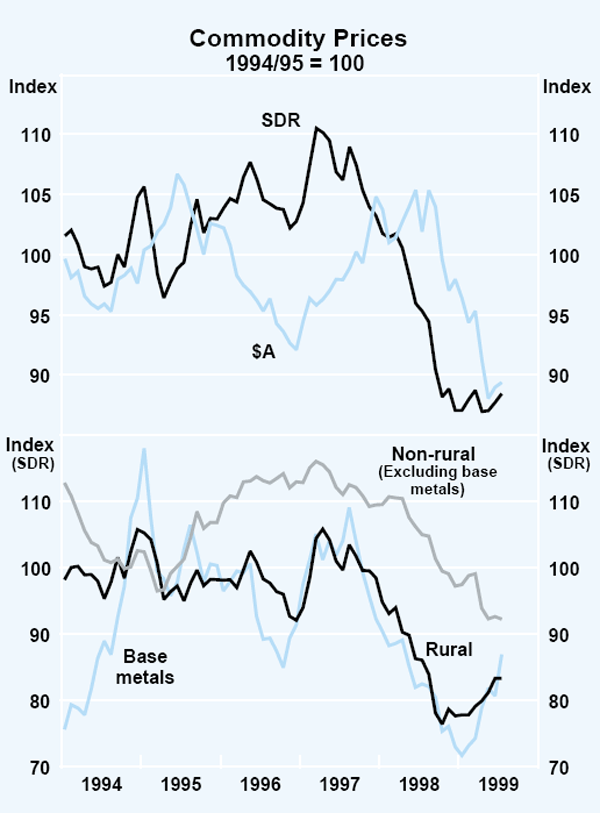
Since the onset of the Asian crisis the overall decline in commodity prices in SDR terms has been around 20 per cent. This weakness in commodity prices was at first offset by a sharp depreciation of the Australian dollar, with the result that commodity prices in Australian dollar terms initially increased. Since late 1998, however, an appreciation of the Australian dollar and some further declines in commodity prices in foreign currency terms have resulted in a sharp fall in commodity prices in Australian dollar terms. In June, the commodity price index in Australian dollars was 13 per cent lower than its average level in 1998.
Despite the substantial fall in commodity prices since the onset of the Asian crisis, the decline in Australia's terms of trade – the ratio of export prices to import prices – has been relatively mild at around 5 per cent to the March quarter. This experience contrasts with the mid 1980s, when a sharp decline in commodity prices was associated with a reduction in Australia's terms of trade of about 17 per cent. The more moderate recent outcome reflects a decrease in the foreign currency price of many of Australia's imports.
Financial Markets
International financial markets
The bullish tone taken by international financial markets in the first quarter of 1999 has continued into the middle of the year, albeit a little tamed by developments in monetary policy in the US, where the US Federal Reserve tightened in June, raising the Federal funds rate by 0.25 per cent to 5.0 per cent. The Fed had instituted a bias to tighten a year ago, but subsequently eased monetary policy in late 1998 (cutting the Federal funds rate in three steps by 0.75 percentage points, to 4.75 per cent) to prevent financial markets from seizing up after the near-collapse of a major US hedge fund, Long-Term Capital Management (LTCM). This action quickly had a settling effect on markets; equity markets in particular regained, and in some cases exceeded, earlier peaks (Graph 17). Against this background, and with the US economy continuing to grow strongly into 1999, it became fairly clear that the insurance the Fed had taken out by easing was no longer needed.
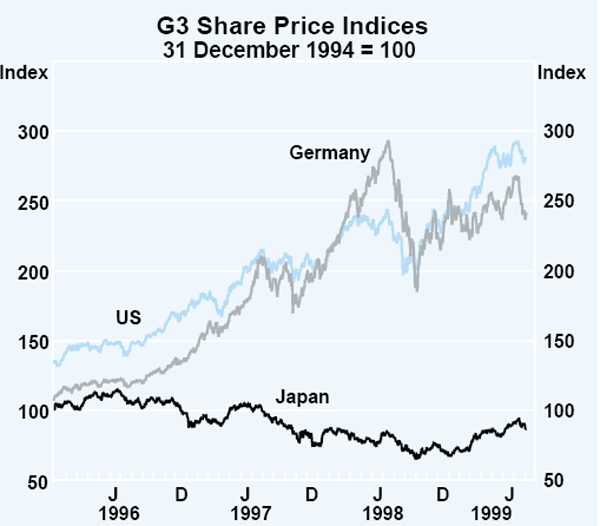
The Fed's action to increase interest rates in June had been well telegraphed, with the FOMC adopting a tightening bias in mid May and Chairman Greenspan making statements questioning whether the low level of interest rates remained necessary in the calmer market conditions of 1999. This helped markets to absorb the tightening when it came. In fact, markets seemed to expect more than was delivered so that, when the Fed did move but removed the tightening bias, there was a short-lived rally. This in turn petered out late in July, after some more hawkish Fed statements restored the watchful tone which had characterised markets for most of June and as economic indicators continued to show strength.
In Europe, the core euro area last eased monetary policy in April 1999, although some other European countries continued easing as late as June, when the UK, Denmark and Norway cut rates. All had short-term rates above those in the euro currency area and had experienced rises in their exchange rates against the euro over the June quarter. With the exception of Norway, however, markets are now expecting that the easing cycle is completed in Europe, given that economic activity seems to be picking up.
The shift in monetary policy stance towards tightening in the US, and the cessation of the easing trend in most other countries, was reflected in a rise in market yields across all maturities. In the case of 10-year bonds, most countries saw yields rise to around the levels prevailing before the LTCM crisis in late 1998 (Graph 18). The sharp dip in yields that took place at that time, as markets became concerned that the world economy might be heading into a deflationary phase, has now been more than reversed.
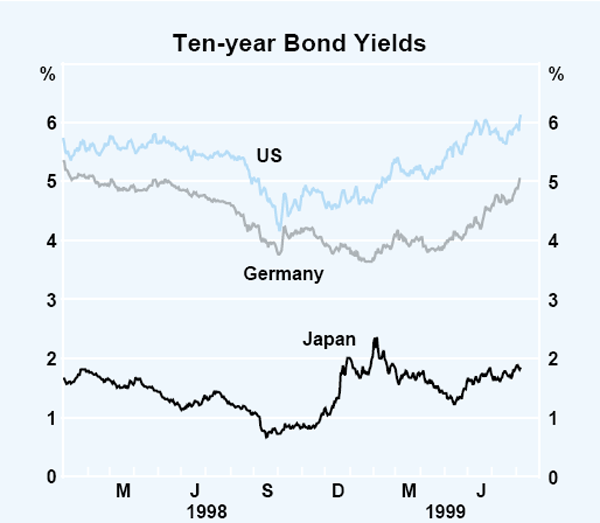
With the US moving to the tightening phase for monetary policy ahead of other countries, it was not surprising that the US dollar remained the strongest of the major currencies in the first half of 1999 (Graph 19). It peaked in May against the Japanese yen and in early July against the euro. The turning points came after the release of economic news suggesting a pick-up in growth in Japan and Europe. In Japan, the release of the first quarter GDP data, which showed surprisingly strong growth, was a major factor turning sentiment, while in Germany markets were particularly impressed by the upturn in business sentiment in June. From a peak of 124 yen, the US dollar subsequently fell to under 115, despite interventions by the Bank of Japan to prevent the yen from strengthening. The euro/US dollar exchange rate strengthened from a low of 1.01 to over 1.07 by late July.

Emerging markets, especially those in Asia, have continued to perform strongly through mid 1999. With economies recovering, interest rates have ceased falling and in some countries – such as Korea – have begun to rise. The exception is Indonesia, where political stability has contributed to a stronger currency and allowed the central bank to bring interest rates down sharply, from about 40 per cent in early April to about 14 per cent now. The picture is more patchy in Latin America, which fell into crisis later than Asia and is not yet showing as strong signs of recovery. In Argentina, where the currency board system means monetary policy is tied to that of the US, markets have reacted negatively to the change in US policy direction as the local economy remains weak.
Consistent with the strong performance of emerging economies, there has been a resumption of capital flows to some economies, mainly in Asia, in recent months. So far this has mainly been in the form of direct investment, but there has been some portfolio investment including from US mutual funds. This has underpinned a sharp recovery in Asian share markets, with some regaining pre-crisis levels. Emerging market credit spreads, which had fallen to about 10 percentage points in early May, have since fluctuated a little above that level (Graph 20). They remain below their peaks of over 15 percentage points, set in September last year, but still well above their pre-crisis levels.

Australian financial markets
The Australian dollar
With the optimistic tone of world markets stemming the fall in commodity prices since March, the Australian dollar moved higher through to early May, reaching around US67 cents (Graph 21). Once the change in direction of US monetary policy was cemented into market expectations later that month, however, it fell back under US65 cents. It has since tended to move with the ebb and flow of expectations about US interest rates, rising (again to over US67 cents) in early July and falling back again towards the end of the month.
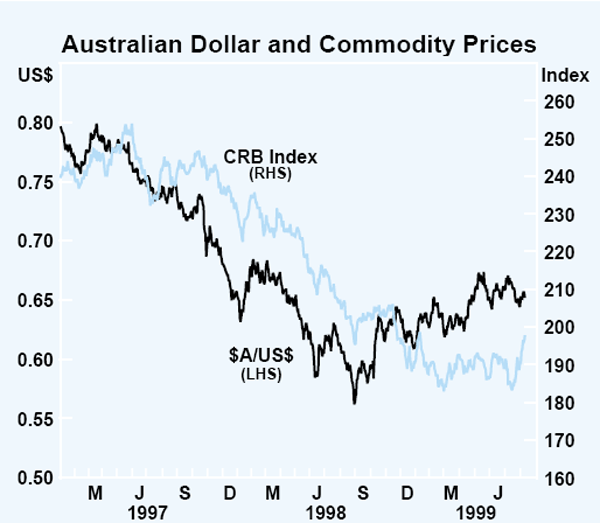
Overall, the rise in the Australian dollar since late 1998 has run ahead of most commodity price indices, following a period earlier in 1998 when the currency fell by more than commodity prices. The major part of this re-alignment took place in late 1998 as hedge funds were forced out of the short positions they had held through much of that year. In 1999, the Australian dollar has risen further against the background of generally flat commodity price indices. Such divergences should not be too surprising, especially in light of the divergent trends exhibited within most commodity price indices; notably, prices of commodities most directly linked to the world industrial production cycle, such as metals, have risen strongly, while those for some food products and gold have fallen. The general factor that seems to be underpinning the recovery in the Australian dollar is the better outlook for the world economy.
Domestic interest rates
While the cash rate – the operational target for monetary policy – has been unchanged at 4.75 per cent since December 1998, market interest rates in Australia began to rise in late April. The main influence was expectations about the Fed's intentions for US monetary policy, as traders, particularly those offshore, saw a Fed tightening as likely eventually to flow through to local interest rates. The yield on 90-day bank bills in Australia moved in April from a level in line with the cash rate target to about 5 per cent by late June, before moving back to about 4.95 per cent (Graph 22). Yields on 180-day bills also rose by about 25 basis points, to a bit above 5 per cent.
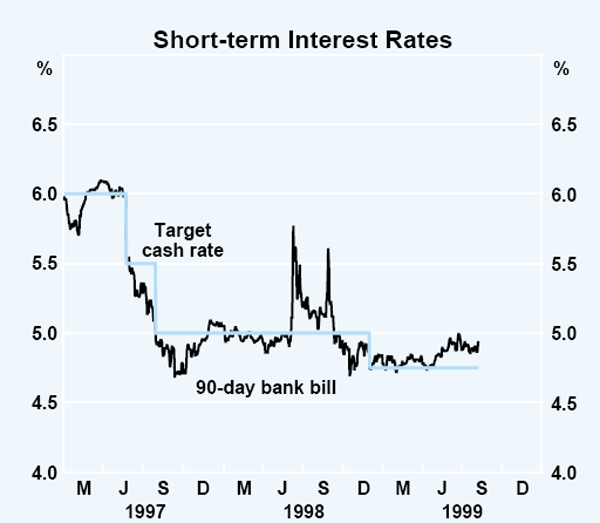
While the bulk of the rise in short-term yields is consistent with the market expecting that monetary policy in Australia might be tightened in coming months, the rise, particularly for 180-day yields, may also reflect concerns about market liquidity around the turn of the year due to the impact of the century change.
The yield on 10-year Government bonds also rose in the period from late April to late June. By early August, yields had moved up further, toward 6.5 per cent, a rise of about 1¾percentage points since their low of December 1998 (Graph 23). At current levels, bond yields have returned to around the levels that prevailed over much of the second half of 1997, when the turbulence in overseas markets saw them begin to drop to the historically low levels of late 1998. Spreads between US and Australian yields have generally stayed in a narrow range in recent months, between 20 and 40 basis points.
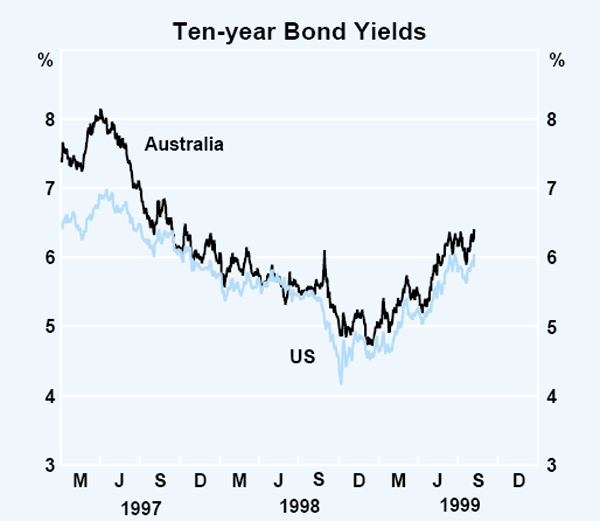
Equity market
As in a number of other countries, share prices in Australia fell from their record high of late April as interest rates moved up. They then moved up and down broadly in parallel with those in the United States. In early August, the All Ordinaries Index was 5½ per cent below its peak in late April, but 21 per cent up on its low of October 1998. This recovery from the lows of last October is less strong than the recovery in US share prices.
The pattern of share prices in Australia changed in recent months (Graph 24). The previous linchpin of growth – share prices of banks – has fallen by 18 per cent from its peak in late April, mainly reflecting expectations of slower growth in bank profits, after the run of strong earnings in recent years. With rises in commodity prices in recent months on the back of improved prospects for world economic growth, resource stocks (excluding gold producers) have surged, to be up by over 55 per cent over their level in December last. The average share price of gold producers has fallen by about 17 per cent from its average level in the March quarter, in response to the fall in the price of gold in this period. The index of share prices of industrial companies – comprising manufacturing, retail, telecommunications and the like – rose steadily, to a new record high in July.
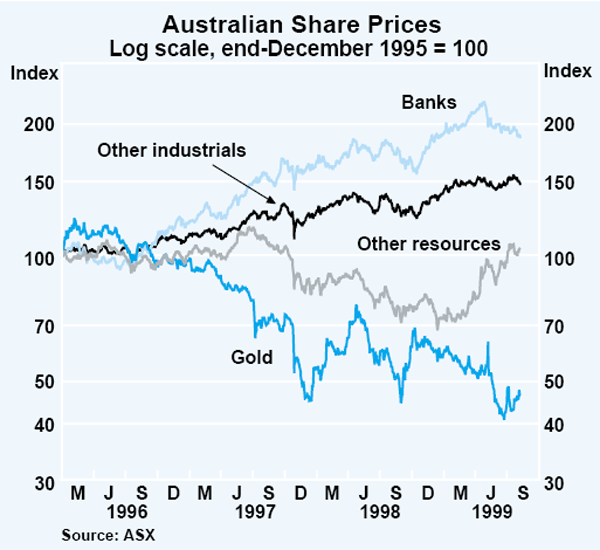
Financial Conditions
Intermediaries' interest rates
Rises in yields in wholesale markets have had some limited effect on interest rates on loans from intermediaries. Increases have flowed most directly into interest rates on fixed-rate lending. Banks' three-year fixed rate housing loans have risen by 55 basis points, and are now at 7.0 per cent. Interest rates on fixed-term personal loans, both secured and unsecured, have also been increased. Banks have also increased three-year fixed-rate small business loans by 100 basis points, to 7.4 per cent.
Two major banks recently also slightly increased their standard variable home loan rates, to bring these lending rates into line with those of the other majors. The average interest rate available on standard variable-rate housing loans from major banks is now 6.55 per cent compared with 6.50 per cent after the cut in interest rates last December (Graph 25). Some banks also increased interest rates on some other lending products to households. These rises reflected two influences: as discussed, the rise in the cost of wholesale funding since intermediaries' rates were cut last December; and strong growth in the demand for credit by households.
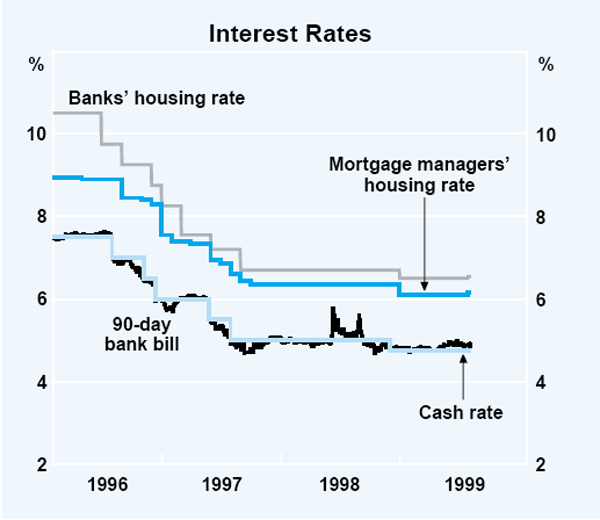
While some banks raised interest rates on standard products, two banks reduced their ‘honeymoon’ rates for new housing borrowers. A leading mortgage manager raised slightly its standard rate in response to increased wholesale funding costs.
Indicator rates on business loans remain at the levels to which they were lowered after the easing of monetary policy. The average interest rate on outstanding variable-rate loans to small businesses, the sum of the indicator rate charged by banks plus individual customer risk margins, was 8.6 per cent in the March quarter (the latest available), down slightly from the December quarter. This rate now fully reflects the December easing of monetary policy. Overall, this rate has fallen by about 1.3 percentage points more than the cash rate since mid 1996.
Financial aggregates
Total credit of financial intermediaries increased at an annual rate of about 11 per cent over the first half of 1999 (Table 6). Growth over the June quarter was a little less than that for March, reflecting a slowing in the growth of personal and business credit, which had picked up significantly in late 1998 and early 1999.
| Six months to: | Three months to: | ||||
|---|---|---|---|---|---|
| Dec 1998 | June 1999 | Mar 1999 | June 1999 | ||
| Total credit | 10.7 | 11.3 | 12.1 | 10.4 | |
| – Personal | 16.3 | 15.7 | 20.6 | 11.0 | |
| – Housing | 11.4 | 14.4 | 13.8 | 15.0 | |
| – Business | 9.0 | 8.0 | 9.0 | 6.9 | |
| Currency | 9.6 | 7.8 | 8.4 | 7.2 | |
| M1 | 0.1 | 14.0 | 14.0 | 14.0 | |
| M3 | 6.0 | 14.3 | 10.4 | 18.4 | |
| Broad money | 7.8 | 12.1 | 7.6 | 16.7 | |
| (a) Adjusted for major breaks in series. | |||||
Currency in circulation grew at an annual rate of around 8 per cent over the first half of the year, consistent with robust consumer spending. Growth in the broader aggregates, M3 and broad money, has picked up noticeably in recent months, after relatively modest growth earlier in the year; annualised growth over the first half of the year was around 12–14 per cent. The recent strength in deposits at financial intermediaries reflects a significant increase in the issuance of certificates of deposit (CDs) and strong growth in other deposits by corporations. Households' deposits with banks grew by only 3½ per cent over the year to the March quarter.
Despite the recent pick-up in growth of broad money and slowdown in growth of credit (to still strong rates), year-ended growth of bank lending remains above that of bank deposits, as has been the case throughout the 1990s (Graph 26). Over the whole period, much of this gap has been funded by banks' net borrowings from abroad. The stock of banks' net offshore liabilities has risen from about $15 billion at the beginning of the decade to around $75 billion in late 1998. Growth in offshore borrowings has slowed significantly since September 1998, partly as a result of unfavourable conditions in international financial markets at that time; this has been offset by increases in banks' raisings of equity and long-term debt securities, in addition to the more rapid growth of deposits noted above. The gap between growth in bank lending and bank deposits in recent years is also partly explained by relatively weak growth in other uses of funds, including declining holdings of government securities by banks.

Non-government bond market
A feature of financing in Australia in recent months is the surge of issuance in the non-government debt market, an experience which has been shared by other countries. Non-government bonds outstanding have increased by 35 per cent in 1999 to end July, to a level – at $54 billion – slightly above that for State government debt (Graph 27).
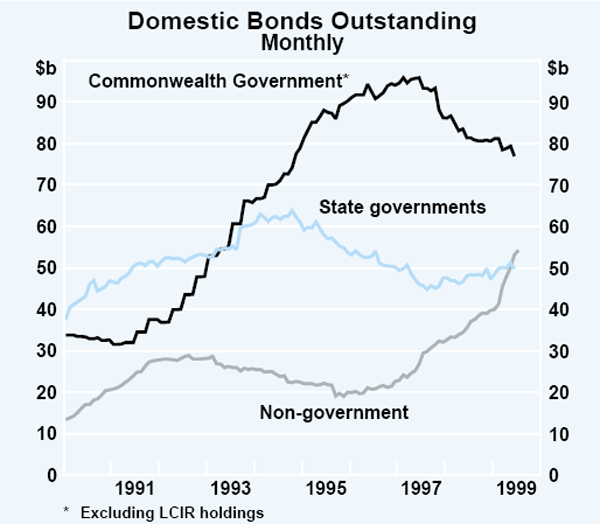
The high rate of issuance of bonds by the non-financial sector has seen total borrowing by that sector increase at a faster rate than intermediated finance (Graph 28). In the year to June, the broader financial aggregate, total private domestic debt[1], rose by 11.8 per cent, compared with a rise of 10.1 per cent in the year to December 1998.
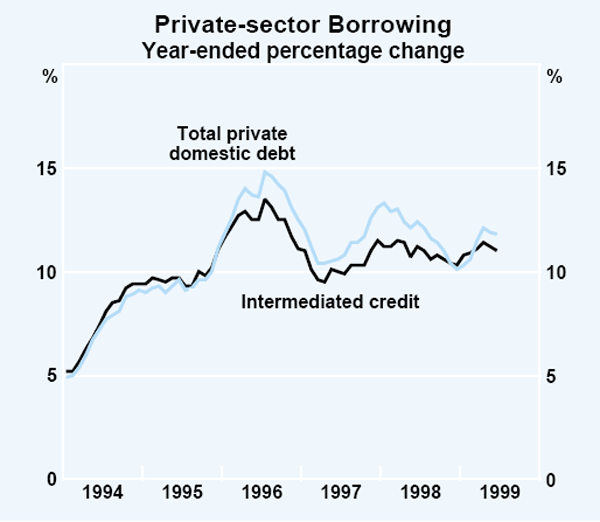
Managed funds
The value of funds under management increased by 3.2 per cent in the March quarter and by 13 per cent over the past year, reflecting both a strong net inflow of funds and increases in asset prices. Assets of public unit trusts recorded the most rapid growth, increasing by 6.1 per cent in the quarter. Assets of cash management trusts have grown at a more moderate pace in recent quarters after enjoying strong growth throughout 1997 and 1998. Holdings of equities and units in trusts increased by 5.5 per cent in the March quarter, accounting for over half of the increase in total managed fund assets (Table 7).
| Quarterly percentage change |
Annual percentage change |
Level $b | Share of total Per cent | |
|---|---|---|---|---|
| Cash & deposits | 2.5 | 7.7 | 35.8 | 7.3 |
| Loans & placements | 0.9 | 9.7 | 24.0 | 4.9 |
| Securities | 1.7 | 14.2 | 132.4 | 26.8 |
| Equities and units in trusts | 5.5 | 12.5 | 145.8 | 29.5 |
| Land & buildings | 2.6 | 12.8 | 52.7 | 10.7 |
| Overseas assets | 2.6 | 18.7 | 86.5 | 17.5 |
| Other assets | 5.2 | −2.2 | 16.5 | 3.3 |
| Total assets | 3.2 | 12.9 | 493.7 | 100.0 |
Inflation Trends and Prospects
Recent developments in inflation
Consumer prices
The Consumer Price Index (CPI) increased by 0.4 per cent in the June quarter, taking the year-ended inflation rate to 1.1 per cent (Graph 29). In underlying terms, prices increased by 0.3–0.5 per cent in the June quarter (Table 8). Most measures of underlying inflation suggest an increase of 1½–2 per cent over the past year and, in year-ended terms, are currently higher than CPI inflation mainly because they are less affected by the impact of the Government's health insurance rebate, introduced at the beginning of this year.
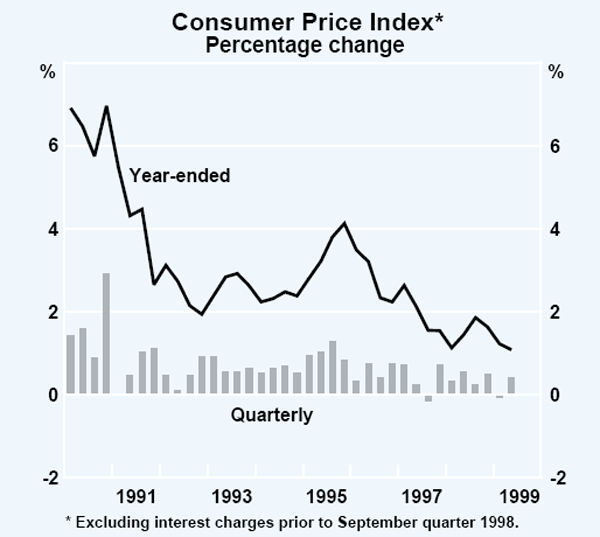
| Quarterly | Year-ended | ||||
|---|---|---|---|---|---|
| Mar 1999 | June 1999 | Mar 1999 | June 1999 | ||
| CPI | −0.1 | 0.4 | 1.2 | 1.1 | |
| CPI excl. ‘volatile items’(a) | 0.0 | 0.3 | 1.1 | 0.9 | |
| Treasury underlying CPI | 0.6 | 0.4 | 1.7 | 1.7 | |
| Private-sector goods and services | 0.6 | 0.4 | 1.5 | 1.6 | |
| Weighted median price change(b) | 0.7 | 0.5 | 1.9 | 1.9 | |
| Trimmed mean price change(b) | 0.5 | 0.4 | 1.4 | 1.4 | |
|
(a) CPI excluding fresh fruit and vegetables and automotive fuel. (b) For details on the calculation of these measures, see ‘Measuring Underlying Inflation’, Reserve Bank of Australia Bulletin, August 1994. |
|||||
Over the past year, ‘house purchase’ costs and motor vehicle prices have had large but opposite movements. The costs of ‘house purchase’, with a weight of around 7 per cent in the CPI basket, rose by 1.0 per cent in the June quarter and by 4.0 per cent over the year to the June quarter. These increases are well in excess of building-materials price inflation and may reflect the recent firmer demand for housing, which has also been evident in a pick-up in established house prices. But the price of motor vehicles fell by 0.4 per cent in the June quarter, to be 3.7 per cent lower over the year. Domestically produced motor vehicles are still subject to strong competition from imported motor vehicles; their prices are likely to fall substantially after the major elements of the tax package are introduced in just under a year's time.
Imported goods prices continue to hold down the aggregate inflation rate, falling again in the June quarter, and are now 1.9 per cent lower than in the corresponding period a year earlier (Graph 30). The quarterly fall was driven by a further decline in the price of imported motor vehicles, although the prices of other imported goods also fell slightly. Measures of domestically sourced inflation – domestically produced goods prices and the price of private-sector services – continue to increase at an annual rate of around 2 per cent.
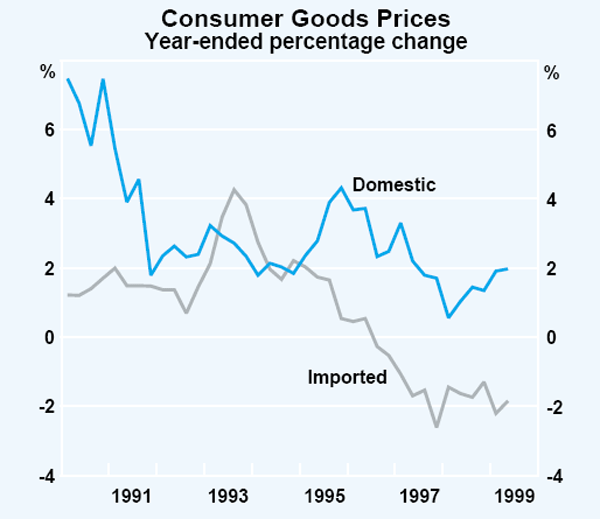
The exchange rate and inflation
Between mid 1997 and late 1998, the Australian dollar depreciated by around 12 per cent in import-weighted terms and by close to 20 per cent against the major currencies. Over the past year or so, generally around half of this depreciation has been unwound. Prices of imported items recorded ‘at the docks’ have risen and fallen broadly in line with these exchange rate movements, increasing by around 12 per cent over the 18 months to late 1998, and subsequently declining by 5 per cent. However, these price movements at the docks appear to have had little or no impact at the retail level, where prices of imported items have generally continued to decline (Graph 31). Since mid 1997, the prices of imported items in the CPI have fallen by around 2¼ per cent, although a rise in the price of overseas holiday travel led to an increase in the price of imported items in the CPI in the June quarter.
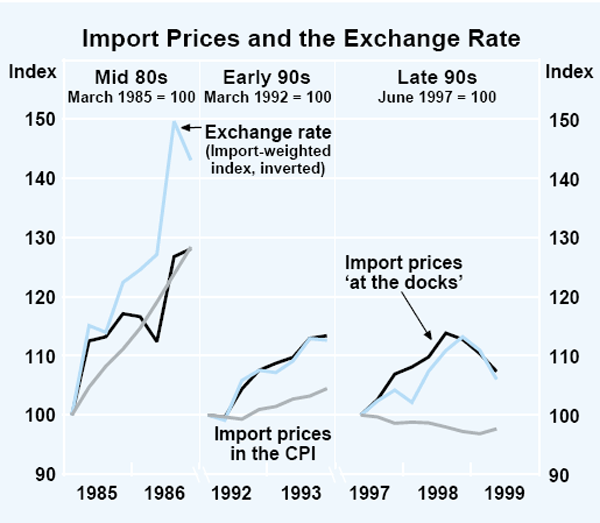
Most of the fall in the price of imported items at the consumer level over the past two years can be explained by a 12½ per cent reduction in the price of imported motor vehicles, which has led to a 7 per cent fall, overall, in the price of cars. As suggested in the May 1999 Semi-Annual Statement, Box D, this may reflect an increase in competition from Asian car manufacturers. The rise in the exchange rate over the past few quarters has gone some way to restoring margins that were squeezed by the prior exchange rate depreciation and the absorption of higher prices at the docks. Assuming recent levels of the exchange rate are sustained, it now seems less likely that the increase in dock prices over the past two years will appear to any great extent in higher consumer prices.
Producer prices
Producer prices generally increased in the June quarter, but earlier declines have kept year-ended inflation rates for these measures very weak or negative (Table 9). An increase in the US dollar price of crude oil of around 35 per cent drove the rise in domestic manufacturers' input costs in the June quarter, but oil prices had fallen in the previous couple of quarters. A fall in the Australian-dollar price of many imported inputs – a result of the higher average exchange rate in the June quarter – provided some offset to the effect of higher oil prices. Final manufacturing prices, excluding oil, fell by 0.3 per cent in the June quarter, reflecting a decline in the price of food, beverages and tobacco goods. Falls in the world price of base metals reduced final manufacturing prices over the year to the June quarter. However, a rebound in these prices in recent months could contribute to rises in producer prices in coming quarters. Input prices in the construction industry remain subdued, despite an increase in demand for house-building materials following the Sydney hailstorm.
| June quarter 1999 | Year to June 1999 | |
|---|---|---|
| Manufacturing | ||
| Input prices | 1.8 | −0.9 |
| – Domestic | 2.6 | −0.2 |
| – Imported | 0.6 | −2.0 |
| Final prices | 0.2 | −0.7 |
| – Excluding petroleum | −0.3 | −0.5 |
| Construction | ||
| Input prices | ||
| – Materials used in house building | −0.3 | 0.2 |
| – Materials used in other building | 0.2 | 0.8 |
| Merchandise trade | ||
| Export prices | −2.7 | −10.2 |
| Import prices | −2.7 | −2.2 |
Labour costs
Consistent with the low inflation outcomes in recent quarters, wages growth remained moderate in the first half of 1999 (Table 10). The Wage Cost Index (WCI) recorded an average increase in wage rates (excluding bonuses) of 0.9 per cent in the March quarter and 3.0 per cent over the year to the March quarter 1999. On a year-ended basis, this measure of wages growth has declined slightly from a rate of 3.3 per cent recorded over the year to the September quarter 1998, the first full year for which it was available. Preliminary data on average weekly ordinary-time earnings (AWOTE) for the three months to May suggest that wages rose by 0.6 per cent in the quarter and by 2.8 per cent over the year. Average weekly earnings (AWE) increased by 2.2 per cent over the year to May 1999.
| Dec 98 | Mar 99 | June 99 | Year to latest |
|
|---|---|---|---|---|
| Quarterly | ||||
| Wage Cost Index (total pay, excluding bonuses) | ||||
| Private | 0.6 | 0.7 | .. | 2.8 |
| Public | 0.6 | 1.5 | .. | 4.1 |
| Total | 0.6 | 0.9 | .. | 3.0 |
| AWOTE | ||||
| Private | 0.3 | 0.0 | .. | 2.6 |
| Public | 1.4 | 1.3 | .. | 5.2 |
| Total | 0.5 | 0.2 | 0.6 | 2.8 |
| AWE | 0.0 | 0.0 | 0.9 | 2.2 |
| Annualised | ||||
| New enterprise agreements | ||||
| Private | 3.9 | 3.9 | .. | |
| Public | 3.8(a) | 3.5 | .. | |
| Total | 3.8(a) | 3.8 | .. | |
| Year-ended | ||||
| Executive remuneration(b) | ||||
| Executive base salaries | 4.8 | 4.7 | 4.7 | |
|
(a) Excludes the South Australian Department of Education agreement. (b) Mercer Cullen Egan Dell Quarterly Salary Review. |
||||
These measures suggest that wages growth during the past year has been more rapid in the public sector than in the private sector. It is possible that there has been some overstatement of recent public-sector wage increases in the WCI, to the extent that the index has been unable to capture the offsetting cost savings arising from the trading off of some employment conditions in one large agreement, because these conditions were not specific to particular jobs. Both the WCI and AWOTE show private-sector wages growing at a little under 3 per cent over the latest year.
Federal enterprise agreements, which provide wage increases for approximately one-fifth of employees, also continued to suggest moderating wages growth in the first quarter of the year. New enterprise agreements certified in the March quarter yielded, on average, wage increases of a little less than 4 per cent per annum to be paid over the next 2½ years (Graph 32). Replacement agreements generally continue to specify smaller annualised wage rises than those provided for by the expiring agreements. The annual growth in executive salaries has also eased over the past 18 months, according to the Mercer Cullen Egan Dell Quarterly Salary Review, from an annual rate of around 6 per cent to 4.7 per cent over the year to the June quarter.
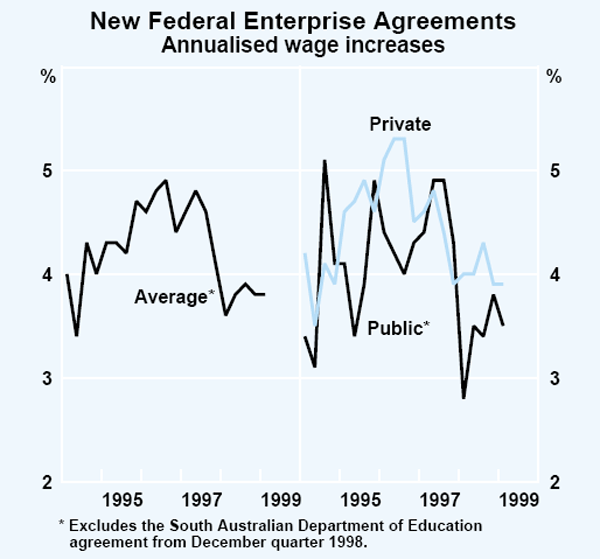
Some business surveys suggest that the low point in wages growth may have been reached. The NAB survey for the June quarter indicated that businesses expect higher wages growth in the quarter ahead, but the increase is moderate and suggests annualised wage increases of under 3 per cent. The ABS business expectations survey for the June quarter also suggests that respondents expect slightly higher wages growth over the year ahead than they expected three months ago.
Inflation expectations
Business surveys indicate that firms plan to increase prices only moderately in the near term (Graph 33). The NAB survey for the June quarter suggests that firms expect to increase prices by 0.3 per cent in the September quarter; the expectation for retailers is slightly lower than the average. The September quarter was the third consecutive quarter for which the ACCI-Westpac survey of manufacturers reported a greater number of firms expecting to decrease than increase prices. The ABS survey of business expectations continues to suggest price rises of around 1 per cent over the year ahead.
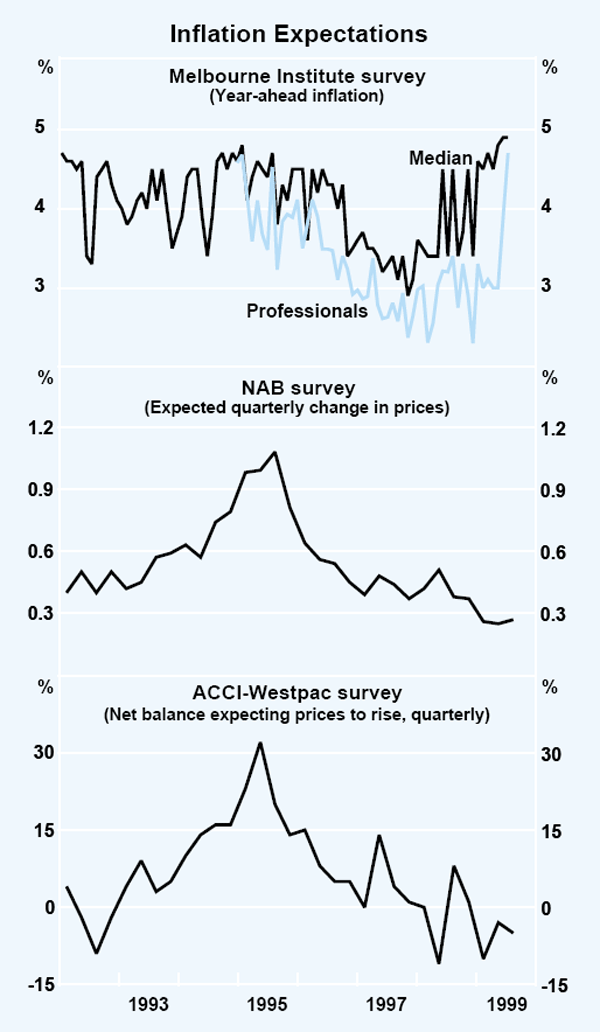
Financial market economists are forecasting moderate price rises over the medium term, although the tax package becomes a significant factor in the forecasts after June 2000. The median response in a survey conducted by the Bank is for CPI inflation to reach 2.2 per cent over the year to June 2000 (Table 11). For the year to June 2001, CPI inflation (excluding the effect of the tax package) is also forecast to be 2.2 per cent. On average, economists in this survey are expecting the first-year effect of the GST to add about 2 per cent to prices, which would take the expected increase in the CPI for the year to June 2001 to 4.2 per cent. These estimates of the first-year effect of the GST are quite dispersed, however, with some economists forecasting that the effect may be around 3 per cent. Inflation forecasts of financial market participants implied by the price of long-dated indexed bonds also appear to reflect a pick-up in inflation expectations over the medium term; the implied forecast is now around 2¾ per cent, a percentage point higher than the expectation held six months ago. This is also likely to include some allowance for the effect of the GST on prices. The survey of trade union officials conducted by the Australian Centre for Industrial Relations Research and Training (ACIRRT) indicates that inflation is expected to be around 2 per cent by mid 2000, rising to 2½ per cent over the following year; many respondents appear not to have incorporated a GST effect in their forecasts.
| Year to June 2000 | Year to June 2001 | |||
|---|---|---|---|---|
| April 1999 | July 1999 | July 1999 | ||
| Market economists(a) | ||||
| CPI | 2.1 | 2.2 | 4.2 | |
| – Excluding GST | 2.2 | |||
| Union officials(b) | ||||
| ‘Inflation’ | 2.0 | 2.0 | 2.5 | |
|
(a) RBA survey of financial market economists. (b) ACIRRT survey of trade union officials. |
||||
Households' inflation expectations for the year ahead, as surveyed by the Melbourne Institute, have risen from around 3¾ per cent in 1998 to around 4¾ per cent on average since the beginning of 1999. The inflation expectations of persons in the survey most likely to be involved in price setting, namely managers and professionals, rose distinctly in June and July. Much of the increase in inflation expectations in recent months appears to be in response to the publicity surrounding the introduction of the Government's tax package, despite the fact that the major changes do not occur until July 2000, which was beyond the horizon of the surveys conducted during the first half of this year.
Inflation outlook
Inflation has edged up from the low point reached in late 1997. Most underlying measures put the rate of inflation over the year to June 1999 at around 1¾ per cent, and at a slightly higher rate over the second half of that period. The gradual increase in inflation has occurred despite continued falls in import prices, implying a modest pick-up in domestically sourced inflation.
Import prices have for some time exerted a restraining influence on consumer price inflation. The extent of this effect was unexpected. Historical experience suggested that, with the exchange rate depreciation between mid 1997 and late 1998 squeezing profit margins on imported items, some eventual impact in the form of higher import prices at the retail level could be expected. But an environment of intense competition in markets for internationally traded goods, partly related to the Asian crisis but also the general world economic slowdown, has resulted in the expected rise in import prices to the consumer being almost totally absent so far, even though measures of import prices at the docks did rise during 1998. Over the past two years, in fact, import prices at the retail level have been declining at an annual rate of more than 1 per cent, directly reducing the CPI inflation rate and putting downward pressure on prices of those domestically produced goods with which they compete. The motor vehicle market, as noted above, offers a prominent example of this process.
How far these competitive conditions will continue to generate declines in retail import prices remains, as in previous reports and Semi-Annual Statements, an important source of uncertainty. The eventual size of the likely pass-through has been reduced by the more recent strengthening of the Australian dollar in the first half of 1999, which has reversed around half of the earlier depreciation; this, if it persists, will allow some scope for profit margins on imported goods to be rebuilt without price increases at the retail level. Notwithstanding these influences, it appears unlikely that import prices will continue to reduce the inflation rate to the same extent as has been the case in the recent past. The somewhat firmer international economic outlook and the recent increases in a number of commodity prices suggest that the competitive forces driving these outcomes are more likely to lessen a little than to intensify. Consistent with this, the reduction in imported goods prices over the past two quarters has been smaller than in earlier quarters, and prices for overseas holiday travel actually increased over the year to June. Were import prices in aggregate to stop falling in the period ahead, that would imply a slight increase in overall inflation from its current rate.
As noted above, there has been a slight increase in the rate of inflation of domestically produced components of the CPI recently, which may reflect stronger demand conditions as the economy has continued to grow at an above-trend pace over the past year. There has been a noticeable increase in consumers' inflation expectations, much of it probably related to uncertainties about the operation of the new tax system. At this stage, however, there is little sign that the recent strength of the labour market is placing any general upward pressure on wage costs. In aggregate, wages are currently increasing at an annual rate of around 3 per cent, with slightly higher increases – between 3½ and 4 per cent – in the enterprise bargaining sector. Productivity continues to grow strongly, which is containing unit labour cost growth to very low levels, although some cyclical decline in productivity growth is likely over the year ahead.
Other factors affecting prices include reductions in wholesale sales tax for some items in July, which will slightly reduce the September quarter CPI, and rises in taxes on tobacco products, which will increase it later in the year. Higher levels of international oil prices (which are assumed to remain at US$20 per barrel) will also have an effect over the next several quarters.
Taking account of all these forces, the Bank's assessment is that inflation as measured by the CPI will increase further in the year ahead, rising a little above 2 per cent on an annual basis during the first half of 2000 as the impact of the health insurance rebate passes. In underlying terms, inflation is likely to be running at around 2 per cent during the first half of 2000.
Looking further ahead, the introduction of the new tax system will be an important factor in inflation outcomes from the second half of 2000. With some of the indirect tax reductions in the package not due to take effect immediately, the initial effect on prices in the September quarter 2000 will be higher than the estimated long-run effect. The Bank intends to abstract from the first-round effects of the GST on the price level, and to focus on the ongoing rate of inflation. One uncertainty in assessing trend inflation post-GST is that the reactions of wage and price setters to the GST are as yet unknown. It is clear that price expectations measured a year ahead have risen on account of the GST, as would be expected, but there is no way at present of assessing whether wage claims will also increase or, even if they do, whether such claims would be successful and so initiate ‘second round’ effects. Prospects for such an outcome would depend in part on the state of the labour market, and also the degree of competition in product markets, at the time. At present, with growth expected to decline a little in the year ahead, the Bank anticipates that there will be relatively little in the way of second-round effects, and that inflation will settle back into the 2–3 per cent range within a year of the GST's implementation. Clearly, this issue warrants close monitoring over the period ahead.
Footnote
Total private domestic debt is intermediated credit plus non-intermediated debt, which is short- and long-term debt securities issued by the non-financial sector in Australia. Components of non-intermediated debt are shown in Bulletin Statistical Table D.6, ‘Debt Securities Issued in Australia’. [1]